July 2011
Re: July 2011
Yes - don't be afraid to push up your ISO a bit on compacts, and those with DSLRs, a lot if needed. Modern sensors are much better at noise reduction at higher ISOs. I don't push my D300 past ISO 400 if I can help it; but with my D7000 I am happy to go to ISO 800 in low light to get the aperture and speeds I want, if necessary.
No need today - ISO 400 sufficient in overcast conditions. Another male Common Blue and mint Brown Argus today in the cemetery.... A lot more Large Whites, several Speckled Wood and Gatekeeper around; still a few Meadow Browns and 1 Large Skipper and RA, but more 2nd generation Holly Blue out....
N
No need today - ISO 400 sufficient in overcast conditions. Another male Common Blue and mint Brown Argus today in the cemetery.... A lot more Large Whites, several Speckled Wood and Gatekeeper around; still a few Meadow Browns and 1 Large Skipper and RA, but more 2nd generation Holly Blue out....
N
"Conservation starts in small places, close to home..."
Re: Chalkhill Blues Collapse
Any changes in management in this time? Grazing by rabbits? Other grazing to manage grassland? Any other reasons you can think of?Perseus wrote:Hello,
27 July 2011
Approaching would should be the peak period for the Chalkhill Blues on Mill Hill with hundreds, perhaps thousands fluttering around, it was dire that I only saw a fleeting view of one male in half an hour on the one acre transect.
I was worried for our Chalk-hill Blues in Cambs - with it being so dry - but, even though they were quite late on one site, all of our sites in Cambridgeshire seem to be doing OK......
N
"Conservation starts in small places, close to home..."
Re: Chalkhill Blues Collapse
NickB wrote:Any changes in management in this time? Grazing by rabbits? Other grazing to manage grassland? Any other reasons you can think of?Perseus wrote:Hello,
27 July 2011
Approaching would should be the peak period for the Chalkhill Blues on Mill Hill with hundreds, perhaps thousands fluttering around, it was dire that I only saw a fleeting view of one male in half an hour on the one acre transect.
I was worried for our Chalk-hill Blues in Cambs - with it being so dry - but, even though they were quite late on one site, all of our sites in Cambridgeshire seem to be doing OK......
N
Limited grazing by cattle has been introduced. However, I do not think this is the reason for any more than a 10% reduction. Adonis Blues numbers have not fallen. Almost all management reasons have been discounted as the main reason. Fall has been observed on non-cattle grazed area but not by quite so much. Mill Hill is not fertile enough for the vegetation to grow excessively and the dryness has made this even more apparent. Predation of larvae is the most likely, whether by parasites or another predator I don't know. As it is mostly the Chalkhill Blues, I suspect parasites or possibly lack of ants. Small Skippers have fallen dramatically as well. There has been a steady fall year by year for eight years. I think this has happened before.
Re: July 2011
The latter half of July 2011 will forever remain synonymous with two species of butterfly for me: Holly Blue and Purple Hairstreak.
I stayed local today as the weather seemed highly unpredictable, and indeed it was nearly 2pm before I ventured out, as Swansea was shrouded in cloud all morning and even though it brightened up in the afternoon, that veil of cloud remained resolute (albeit thinner) throughout.
I took a walk down Cwm Clydach, which is a steep wooded gorge about a mile from where I live. Driving into the car park I had to veer left to avoid a 'puddling' Holly Blue and as I got out of the car I was 'intercepted' by a Red Admiral.
The walk through the wooded valley was fairly unremarkable, though I was shocked to find a female Purple Hairstreak basking on an immature oak about half a mile up the path:
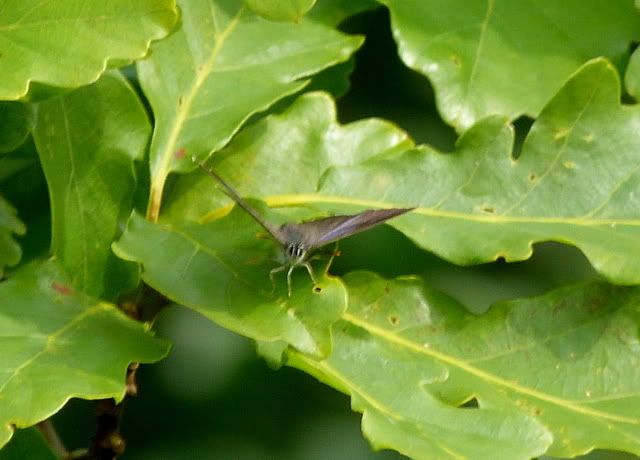
As ever, the PH was difficult to view, as the oak was growing on a steep embankment comprised of coal mining slurry from the pits that closed here in 1962.
Butterfly numbers weren't great, however I saw 11 different species, and one of the most conspicuous (again) was Holly Blue.
Is it me or is this butterfly having a good year? I saw 7 or 8 today, and finally, after two years of trying, I managed to chance upon a female which was in open wing basking mode:
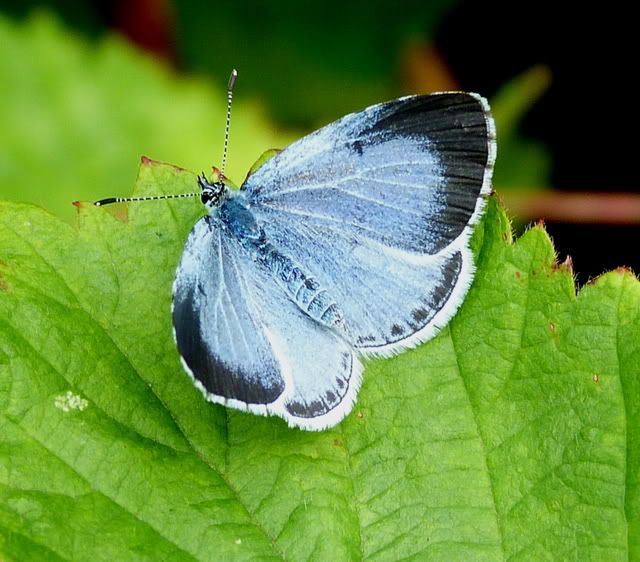
I stayed local today as the weather seemed highly unpredictable, and indeed it was nearly 2pm before I ventured out, as Swansea was shrouded in cloud all morning and even though it brightened up in the afternoon, that veil of cloud remained resolute (albeit thinner) throughout.
I took a walk down Cwm Clydach, which is a steep wooded gorge about a mile from where I live. Driving into the car park I had to veer left to avoid a 'puddling' Holly Blue and as I got out of the car I was 'intercepted' by a Red Admiral.
The walk through the wooded valley was fairly unremarkable, though I was shocked to find a female Purple Hairstreak basking on an immature oak about half a mile up the path:

As ever, the PH was difficult to view, as the oak was growing on a steep embankment comprised of coal mining slurry from the pits that closed here in 1962.
Butterfly numbers weren't great, however I saw 11 different species, and one of the most conspicuous (again) was Holly Blue.
Is it me or is this butterfly having a good year? I saw 7 or 8 today, and finally, after two years of trying, I managed to chance upon a female which was in open wing basking mode:

Re: July 2011
Hi Perseus,
Do the cattle range over all the site? Or are areas fenced-off and left completely untouched for all, or part of, the year?
Could it be that grazing through the season does not produce the right type of sward, compared to that which suites Adonis....?
Thomas and Lewington state (in Butterflies of Britain & Ireland) that Chalk-hill are "often common on sites where grazing has been temporarily relaxed, releasing the close-cropped stumps (of Horseshoe Vetch) to produce a luxuriance of delicate leaflets".
I wonder if dessication during the drought in the early part of the year may have similarly reduced the lush and leafy growth preferred for egg-laying and larval development, in the same way that over-grazing, or at the wrong times, may depress numbers?
N
Do the cattle range over all the site? Or are areas fenced-off and left completely untouched for all, or part of, the year?
Could it be that grazing through the season does not produce the right type of sward, compared to that which suites Adonis....?
Thomas and Lewington state (in Butterflies of Britain & Ireland) that Chalk-hill are "often common on sites where grazing has been temporarily relaxed, releasing the close-cropped stumps (of Horseshoe Vetch) to produce a luxuriance of delicate leaflets".
I wonder if dessication during the drought in the early part of the year may have similarly reduced the lush and leafy growth preferred for egg-laying and larval development, in the same way that over-grazing, or at the wrong times, may depress numbers?
N
"Conservation starts in small places, close to home..."
Re: July 2011
NickB wrote:Hi Perseus,
Do the cattle range over all the site? Or are areas fenced-off and left completely untouched for all, or part of, the year?
Could it be that grazing through the season does not produce the right type of sward, compared to that which suites Adonis....?
Thomas and Lewington state (in Butterflies of Britain & Ireland) that Chalk-hill are "often common on sites where grazing has been temporarily relaxed, releasing the close-cropped stumps (of Horseshoe Vetch) to produce a luxuriance of delicate leaflets".
I wonder if dessication during the drought in the early part of the year may have similarly reduced the lush and leafy growth preferred for egg-laying and larval development, in the same way that over-grazing, or at the wrong times, may depress numbers?
N
Mill Hill is not agricultural land and we would not normally number like pastures and the sward does not grow long on the lower slopes because it is not fertile enough. In good years, the Chalkhill Blues are abundant, over 500 an acre single day. day count. Cattle destroy Horseshoe Vetch but this has not happened because of the cattle. The density has not reduced. If it had this could explain it, but the leaf growth is about the same as usual, but this year the flowering diminished by about 75%, but I put this down to the dry weather. The leaves are the prostrate type and they might spread out even more in a dry spring. Some areas of Horseshoe Vetch have been destroyed (10% tops) but this would not account for a 99% fall in numbers of Chalkhill Blues.
if the Horseshee Vetch was not still dense this could be the explanation. But it is not.
Mill Hill Reports 2011
http://www.glaucus.org.uk/MillHill2011.html
Mill Hill and its Butterflies
http://www.glaucus.org.uk/MillHill2009Article.htm
Re: July 2011
Travelled back down from Yorkshire today, and the weather improved every step of the way. I stopped briefly in a layby on the Southam Bypass (south of Coventry) where the banks are covered in Kidney Vetch. I have seen Small Blues here, but there were no second brood individuals this afternoon. There were however a dozen Common Blues, several Brown Argus and a few Essex Skippers on the parched banks which resembled nothing so much as a Mediterranean hillside.
Down the the M40, and a stop at Aston Rowant was a must - impossible to drive past at this time of year. I encountered good numbers of Chalkhill Blues, Small Coppers, Brown Argus, Meadow Browns, dozens of Silver-spotted Skippers, a couple of Brimstones and finally one Lee Hurrell. (Nice to see you, Lee!) Bearing the worrying report about Mill Hill in mind, I think the Chalkhill Blues at Aston Rowant are every bit as numerous as in recent years.
Dave
Down the the M40, and a stop at Aston Rowant was a must - impossible to drive past at this time of year. I encountered good numbers of Chalkhill Blues, Small Coppers, Brown Argus, Meadow Browns, dozens of Silver-spotted Skippers, a couple of Brimstones and finally one Lee Hurrell. (Nice to see you, Lee!) Bearing the worrying report about Mill Hill in mind, I think the Chalkhill Blues at Aston Rowant are every bit as numerous as in recent years.
Dave
Last edited by millerd on Sat Jul 30, 2011 10:27 pm, edited 1 time in total.
-
essexbuzzard
- Posts: 2485
- Joined: Sun Jul 24, 2011 6:23 pm
Re: July 2011
The turf at Mill Hill is too short to support high numbers of Chalkhill Blues,in my opinion. This is shown by the high numbers of Adonis Blues that fly there.Sites that support strong Adonis colonies rarely support good Chalkhill numbers,because these need longer Horseshoe Vetch plants.High numbers of Chalkhill Blues still fly at several Sussex sites, Windover Hill for example,where the turf is thicker.Approaching would should be the peak period for the Chalkhill Blues on Mill Hill with hundreds, perhaps thousands fluttering around, it was dire that I only saw a fleeting view of one male in half an hour on the one acre transect.
Regards,
Mark.
Re: July 2011
essexbuzzard wrote:The turf at Mill Hill is too short to support high numbers of Chalkhill Blues,in my opinion. This is shown by the high numbers of Adonis Blues that fly there.Sites that support strong Adonis colonies rarely support good Chalkhill numbers,because these need longer Horseshoe Vetch plants.High numbers of Chalkhill Blues still fly at several Sussex sites, Windover Hill for example,where the turf is thicker.Approaching would should be the peak period for the Chalkhill Blues on Mill Hill with hundreds, perhaps thousands fluttering around, it was dire that I only saw a fleeting view of one male in half an hour on the one acre transect.
Regards,
Mark.
We have first hand reports of Chalkhill Blues on Mill Hill going back over 200 years with numbers recorded at 50,000+ in living memory and I have seen 4000+ in successive years in the late seventies, and reports of 6000+ day count in years between then and 2003 and when I was a kid there were far more as the suitable land was larger. The highest numbers have always been where there is no grass at all. Chalkhill Blues stronghold are now chalk pits and quarries. The Horsehoe Vetch requires hardly any soil, just the moss cover.

http://www.glaucus.org.uk/Hippocrepis_comosa.html
Adonis Blues are more widespread over the local downs so they are less fussy about their Horseshoe Vetch, if climatic conditions allow. The slopes of Mill Hill are not grass but Horseshoe Vetch and other herbs. Intermittent horse grazing caused patches of grass to appear. Chalkhill ecology succession is from bare chalk to mosses and then herbs like Horseshoe vetch. Grass only appears with grazing by voles and mice at first.
I have observed that dense patches of Horseshoe Vetch of the prostrate type are essential for Chalkhill Blues, whereas the female of the Adonis Blue is more careful where she lays her eggs. Therefore the Adonis Blue is more widespread but less numbers when present which is just about everywhere, even when the Horseshoe Vetch occurs sparsely and on pastures. There are large areas (5+ acres) of Horseshoe Vetch on the downs where only Adonis occurs. This is a more upright form of the plant.
There has been a fall of Meadow Browns as well, but they are common but not abundant.
Chalkhill Blues tend to use Cocksfoot for roosting. They fly off the site in dry summers. Common Blues have also reduced dramatically but erratically on both Mill Hill and Lancing Ring meadows. Again, I cannot say management is the reason, but it might be with these?
Re: July 2011
Well, for Chalkhill Blues, take yourselves off to Denbies - the hillside is absolutely alive with them. There must be thousands, and they really do rise up in clouds as you walk along. Since the last Marbled Whites disappeared during the week, they've had the hillside pretty well to themselves, but today I saw the first of the second brood Adonis Blues - small numbers only as yet. I also spotted a second brood Dingy Skipper.
Photos to follow a bit later, including a contender for the tastiest bit of dog poo in the country...
Dave
Photos to follow a bit later, including a contender for the tastiest bit of dog poo in the country...
Dave
Re: July 2011
Hello,
31 July 2011
At the usual peak date for Chalkhill Blues on Mill Hill I went directly to the lower slopes in the late morning recording 37 (including four females) on the one acre transect before 11.20 am and an estimated 35 mostly males in the following 15 minutes. Most of these appeared fresh and could have just emerged. This was still a poor total of 72 per acre on the lower slopes and two elsewhere on the hill. In a good year they should rise up in clouds so you think you cannot help treading on them.
Chalkhill Blues (Shoreham area, Sussex)
viewtopic.php?p=8761
Without making more than a cursory attempt to search, I discovered at least half a dozen second brood Dingy Skippers, five on the lower slopes of Mill Hill, and one on the middle slopes in the the Triangle area amongst the Wild Basil. There could have easily been more. Fourteen butterfly species were seen in the late morning including a further 20+ Chalkhill Blues on the Mill Hill Cutting (SW).
Mill Hill Reports 2011
http://www.glaucus.org.uk/MillHill2011.html
Mill Hill and its Butterflies
http://www.glaucus.org.uk/MillHill2009Article.htm
Adur Butterfly & Large Moth List
http://www.glaucus.org.uk/Butterfly-list2011.html
Cheers
Andy Horton
glaucus@hotmail.com
Adur Valley Nature Notes
http://www.glaucus.org.uk/Adur2011.html
Adur Valley Nature Notes: July 2011
http://www.glaucus.org.uk/July2011.html
Sussex Downs Facebook Group
http://www.facebook.com/group.php?gid=111843132181316
31 July 2011
At the usual peak date for Chalkhill Blues on Mill Hill I went directly to the lower slopes in the late morning recording 37 (including four females) on the one acre transect before 11.20 am and an estimated 35 mostly males in the following 15 minutes. Most of these appeared fresh and could have just emerged. This was still a poor total of 72 per acre on the lower slopes and two elsewhere on the hill. In a good year they should rise up in clouds so you think you cannot help treading on them.
Chalkhill Blues (Shoreham area, Sussex)
viewtopic.php?p=8761
Without making more than a cursory attempt to search, I discovered at least half a dozen second brood Dingy Skippers, five on the lower slopes of Mill Hill, and one on the middle slopes in the the Triangle area amongst the Wild Basil. There could have easily been more. Fourteen butterfly species were seen in the late morning including a further 20+ Chalkhill Blues on the Mill Hill Cutting (SW).
Mill Hill Reports 2011
http://www.glaucus.org.uk/MillHill2011.html
Mill Hill and its Butterflies
http://www.glaucus.org.uk/MillHill2009Article.htm
Adur Butterfly & Large Moth List
http://www.glaucus.org.uk/Butterfly-list2011.html
Cheers
Andy Horton
glaucus@hotmail.com
Adur Valley Nature Notes
http://www.glaucus.org.uk/Adur2011.html
Adur Valley Nature Notes: July 2011
http://www.glaucus.org.uk/July2011.html
Sussex Downs Facebook Group
http://www.facebook.com/group.php?gid=111843132181316
Re: July 2011
Saturday 30th July – Alners Gorse, Dorset
Although the forecast for Saturday was ‘decidedly iffy’ or reasonable depending on which forecast you looked at, we decided to go to Alners Gorse in Dorset. Karen and I had been there a couple of times in previous years and had yet to go on a really good day...so we were hoping to ‘break our duck’ with this visit. As usual we left Wales early and by the time we were driving into the edges of Dorset it started raining (not forecast at all) what’s worse there was quite a bit of water sitting on the roads, so it looked like it might have been coming down for some time . We got to Alners Gorse about 9:30 and immediately met up with Bill (Willrow) who we’d agreed to meet at the site. Despite the grey skies (and somewhat low temperatures) he’d already seen one Brown Hairstreak flying across the avenue lined with Lime trees that leads to the main lower fields.
. We got to Alners Gorse about 9:30 and immediately met up with Bill (Willrow) who we’d agreed to meet at the site. Despite the grey skies (and somewhat low temperatures) he’d already seen one Brown Hairstreak flying across the avenue lined with Lime trees that leads to the main lower fields. 
Right up until 1pm we wandered round the small reserve as we watched the temperature slowly climb as the sun tried it’s best to break through . There were plenty of Gatekeepers, Meadow Browns, Speckled Woods, Small Skippers and a few Marbled Whites about but no sign of any Hairstreaks
. There were plenty of Gatekeepers, Meadow Browns, Speckled Woods, Small Skippers and a few Marbled Whites about but no sign of any Hairstreaks  . As we watched the local rabbits come and go across the main walk we met several other Lepidopterists who had come from multiple destinations. It seemed as we chatted that nobody was seeing a great deal. By mid-afternoon we had got warmer temperatures and seen our first Brown Hairstreak and some Purple Hairstreaks at the end of the reserve, but these were all largely staying in the trees
. As we watched the local rabbits come and go across the main walk we met several other Lepidopterists who had come from multiple destinations. It seemed as we chatted that nobody was seeing a great deal. By mid-afternoon we had got warmer temperatures and seen our first Brown Hairstreak and some Purple Hairstreaks at the end of the reserve, but these were all largely staying in the trees  . There were also some nice Red Admirals, Peacocks, Whites, Commas and some Silver-Washed Fritillaries flying about in the slightly warm, humid weather and also several Holly Blues (including a nice male warming up in the sunshine at the car park)
. There were also some nice Red Admirals, Peacocks, Whites, Commas and some Silver-Washed Fritillaries flying about in the slightly warm, humid weather and also several Holly Blues (including a nice male warming up in the sunshine at the car park)  .
.
We stayed on until after 5pm and luckily the weather broke into proper sunshine (after most of the visitors had left): we’d ventured back to the far end of the reserve where there were plenty of small Alder Buckthorn bushes (Zonda had pointed out that these were favourites of the Hairstreaks). The Purple Hairstreaks would come down in ones and twos to the remaining flowers (though most of these had nicks and holes in their wings) along with a few Holly Blues. Finally in one of the glades I spotted a very fresh Brown Hairstreak : Bill and I took photos just before the BH flew onto one of the slightly higher branches. At this point Bill did his best to encourage the individual down with the aid of some local branches
: Bill and I took photos just before the BH flew onto one of the slightly higher branches. At this point Bill did his best to encourage the individual down with the aid of some local branches  , but the BH instead ended up flying higher into an Oak
, but the BH instead ended up flying higher into an Oak  . At this point we noticed another 3 or 4 Brown Hairstreaks, all fresh, but all staying up in the upper branches
. At this point we noticed another 3 or 4 Brown Hairstreaks, all fresh, but all staying up in the upper branches  .
.
We stayed on in the reserve until just after 6pm and decided to head home as we all had a long way to drive (Karen and I stopped at the Indian Restaurant just past Stalbridge - thank god, we were dying for some food! ). Again the feeling we left with from the day was that Alners Gorse is a great place to visit, but the lower-than-summer-temperatures hadn’t helped - but at least we had seen some nice individual Brown Hairstreaks.
). Again the feeling we left with from the day was that Alners Gorse is a great place to visit, but the lower-than-summer-temperatures hadn’t helped - but at least we had seen some nice individual Brown Hairstreaks.
Michael
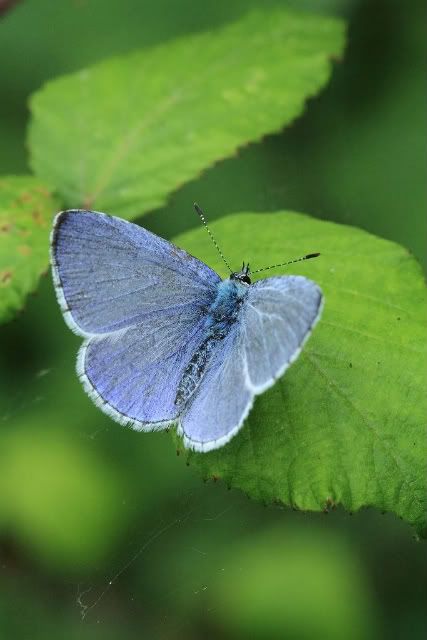
A pretty male Holly Blue opens its wings by the car park as Bill has some sandwiches!
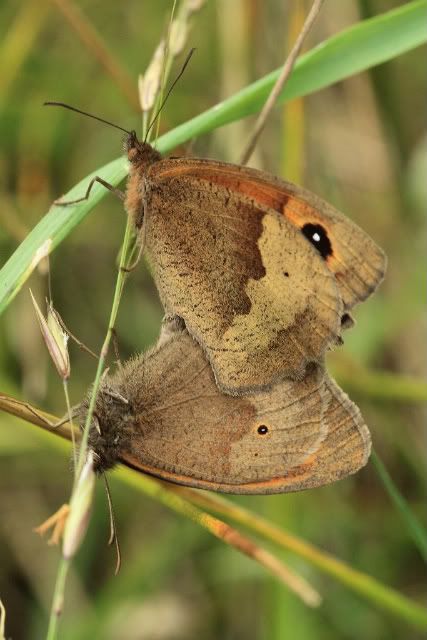
At least these Meadow Browns are making the best of the weather...
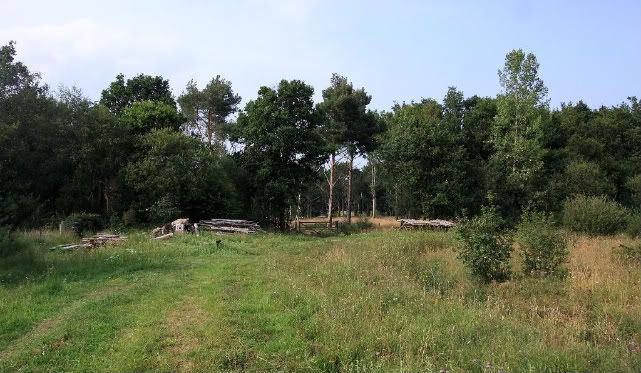
The lower edges of the reserve - where Hairstreaks would be seen, if only in trees..
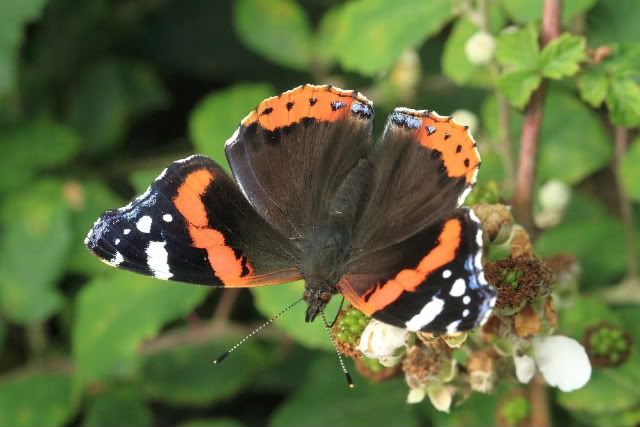
One of the very nice (and fresh) Red Admirals on bramble flowers.
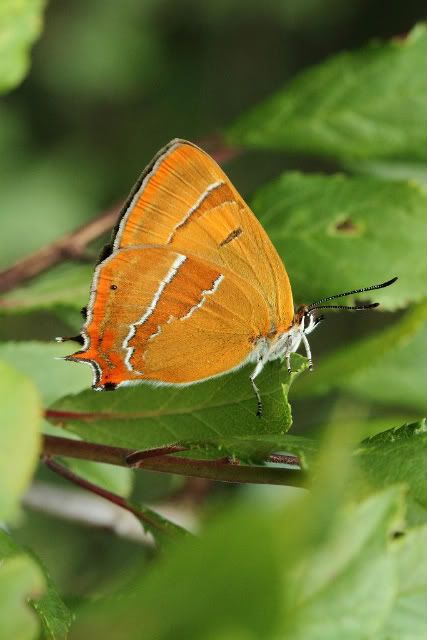
Finally, a nice Brown Hairstreak is found in one of the lower glades.
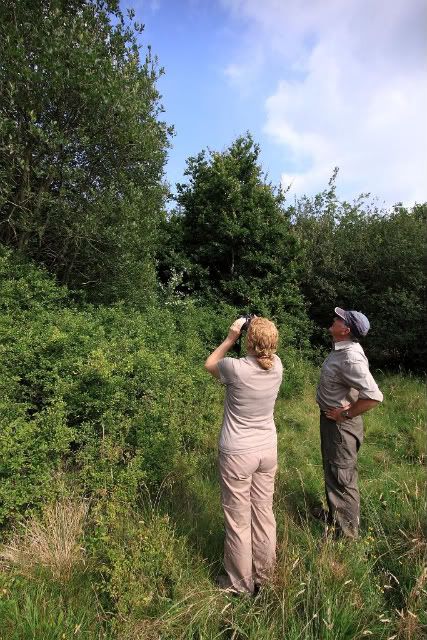
Karen and Bill try and follow the Brown Hairstreaks up into the trees.
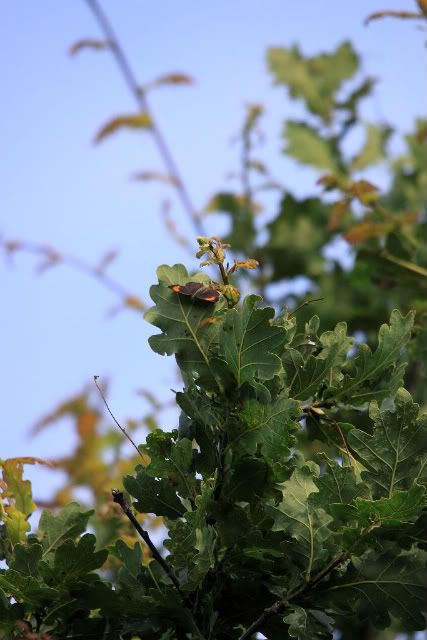
A more 'normal' view - a Female Brown Hairstreak sits in the Oak, well out of reach!
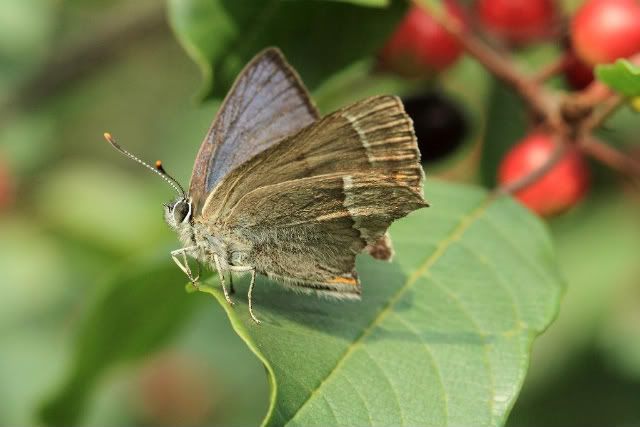
One of the Male Purple Hairstreaks (with wing damage, unfortunately!) on one of the Alder Buckthorn bushes.
Although the forecast for Saturday was ‘decidedly iffy’ or reasonable depending on which forecast you looked at, we decided to go to Alners Gorse in Dorset. Karen and I had been there a couple of times in previous years and had yet to go on a really good day...so we were hoping to ‘break our duck’ with this visit. As usual we left Wales early and by the time we were driving into the edges of Dorset it started raining (not forecast at all) what’s worse there was quite a bit of water sitting on the roads, so it looked like it might have been coming down for some time
Right up until 1pm we wandered round the small reserve as we watched the temperature slowly climb as the sun tried it’s best to break through
We stayed on until after 5pm and luckily the weather broke into proper sunshine (after most of the visitors had left): we’d ventured back to the far end of the reserve where there were plenty of small Alder Buckthorn bushes (Zonda had pointed out that these were favourites of the Hairstreaks). The Purple Hairstreaks would come down in ones and twos to the remaining flowers (though most of these had nicks and holes in their wings) along with a few Holly Blues. Finally in one of the glades I spotted a very fresh Brown Hairstreak
We stayed on in the reserve until just after 6pm and decided to head home as we all had a long way to drive (Karen and I stopped at the Indian Restaurant just past Stalbridge - thank god, we were dying for some food!
Michael

A pretty male Holly Blue opens its wings by the car park as Bill has some sandwiches!

At least these Meadow Browns are making the best of the weather...

The lower edges of the reserve - where Hairstreaks would be seen, if only in trees..

One of the very nice (and fresh) Red Admirals on bramble flowers.

Finally, a nice Brown Hairstreak is found in one of the lower glades.

Karen and Bill try and follow the Brown Hairstreaks up into the trees.

A more 'normal' view - a Female Brown Hairstreak sits in the Oak, well out of reach!

One of the Male Purple Hairstreaks (with wing damage, unfortunately!) on one of the Alder Buckthorn bushes.
Last edited by Michaeljf on Tue Aug 16, 2011 8:25 pm, edited 1 time in total.
Re: July 2011
As promised, some photos from Denbies today.
There are no less than 18 butterflies on or close to the piece of excrement. All are Chalkhills, except for a single Adonis in the middle somewhere. Other similar leavings elsewhere on the hillside had congregations, but none so populous!
Dave
There are no less than 18 butterflies on or close to the piece of excrement. All are Chalkhills, except for a single Adonis in the middle somewhere. Other similar leavings elsewhere on the hillside had congregations, but none so populous!
Dave
Re: July 2011
Slightly higher branchesMichaeljf wrote: Bill and I took photos just before the BH flew onto one of the slightly higher branches
Great report Michael with some smashing pics too, a very enjoyable day's butterflying with you and your lovely wife Karen
Bill
Why not visit my website at http://www.dragonfly-days.co.uk
Grayling
Just had time yesterday afternoon to quickly visit Bleak Down near Rookley on the Isle of Wight to see if the grayling were present. In 5 minutes I saw 7 ,so there are probably considerably more there. 
Re: July 2011
Hi Bill,
thanks for the kind comments - I think you'll find that the remedy for Hairstreak crooked-neck is Grayling-counting opposite-crooked neck so you'll be OK in a day or so!
Michael
thanks for the kind comments - I think you'll find that the remedy for Hairstreak crooked-neck is Grayling-counting opposite-crooked neck so you'll be OK in a day or so!
Michael
Re: July 2011
Sunday 31 July - Part 1
With the season nearing its end I thought I'd have one last blitz by attempting to discover how many species of butterfly I could find in a single day. I figured a woodland location, followed by a scrub then a chalkland one would provide a good range of diverse habitats so I set off from Swansea at 6.50am to Bentley Wood near Salisbury, arriving at 9.30.
The first thing I noticed was the collection of rotting fruit left for the Emperors on the bench in the car park. This proved attractive to several butterflies, including a Silver Washed Fritillary and this Red Admiral:
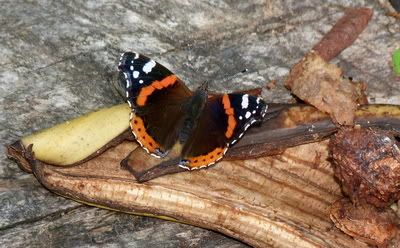
On the adjacent bench, a fresh Peacock was basking in the weak sunlight:
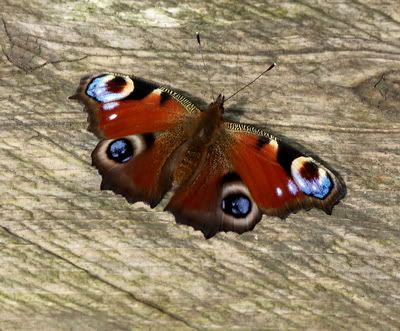
Quite a few of the female SWFs had that greenish tinge associated with the Valezina form. Of course, by now they're faded and tatty, but is this a Valezina?
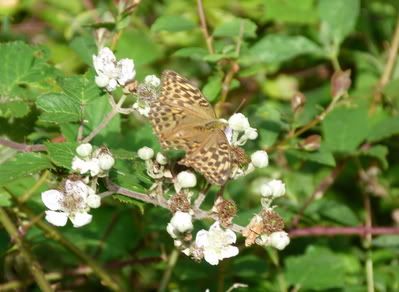
There was a fairly docile Small White on one of the verges, and it struck me how few of this species I've seen this year:
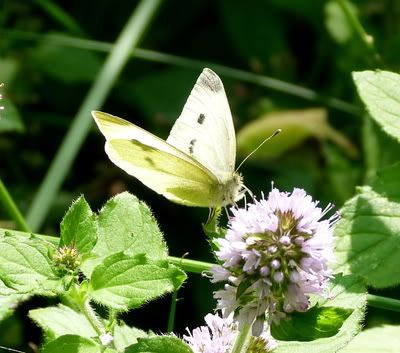
In total, I saw 12 species at Bentley:
Red Admiral
Silver Washed Fritillary
Ringlet
Speckled Wood
Peacock
Large Skipper
Green Veined White
Hedge Brown
Meadow Brown
Small White
Large White
Brimstone
With the season nearing its end I thought I'd have one last blitz by attempting to discover how many species of butterfly I could find in a single day. I figured a woodland location, followed by a scrub then a chalkland one would provide a good range of diverse habitats so I set off from Swansea at 6.50am to Bentley Wood near Salisbury, arriving at 9.30.
The first thing I noticed was the collection of rotting fruit left for the Emperors on the bench in the car park. This proved attractive to several butterflies, including a Silver Washed Fritillary and this Red Admiral:

On the adjacent bench, a fresh Peacock was basking in the weak sunlight:

Quite a few of the female SWFs had that greenish tinge associated with the Valezina form. Of course, by now they're faded and tatty, but is this a Valezina?

There was a fairly docile Small White on one of the verges, and it struck me how few of this species I've seen this year:

In total, I saw 12 species at Bentley:
Red Admiral
Silver Washed Fritillary
Ringlet
Speckled Wood
Peacock
Large Skipper
Green Veined White
Hedge Brown
Meadow Brown
Small White
Large White
Brimstone
Last edited by David M on Mon Aug 01, 2011 9:20 am, edited 5 times in total.
Re: July 2011
Nice oneMichaeljf wrote:Hi Bill,
thanks for the kind comments - I think you'll find that the remedy for Hairstreak crooked-neck is Grayling-counting opposite-crooked neck so you'll be OK in a day or so!
Michael
Re: July 2011
Sunday 31 July - Part 2
After leaving Bentley Wood, I drove to Alner's Gorse, arriving at about 12.30pm. My first surprise was bumping into fellow UKB member Jenks, who was bemoaning the fact that he'd forgotten his password and couldn't post at the moment! Still, he reassured me by telling me he'd seen 4 Brown Hairstreaks so I trotted off round the corner and sure enough, there was a male on the brambles as well as another male on a thistle.
After observing these two for a while, I meandered through this Hairstreak heaven, and cursed when I walked under an Oak and disturbed a Purple Hairstreak that must have been at shoulder level.
It went temporarily cloudy, so I explored some of the grassland before returning to the same swathe of hedgerow that had produced the first BH. This time there was a female nectaring wings shut on bramble. She had an audience for a while before people drifted off leaving just me as the sole observer. I gently rustled the foliage beneath her using my bespoke 'Hairstreak Stick', and she fluttered around before landing on a leaf immediately in front of my nose. Now in basking rather than feeding mode, it wasn't long before those wings slowly eased apart:
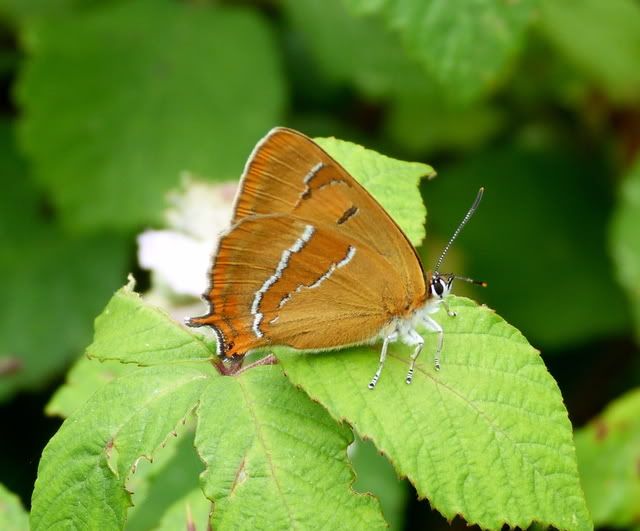
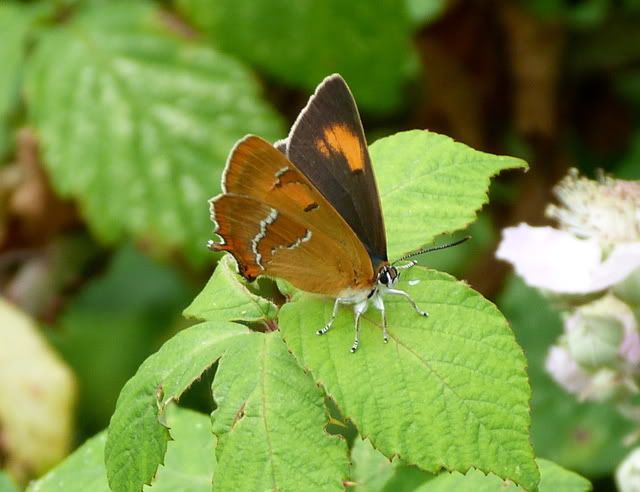
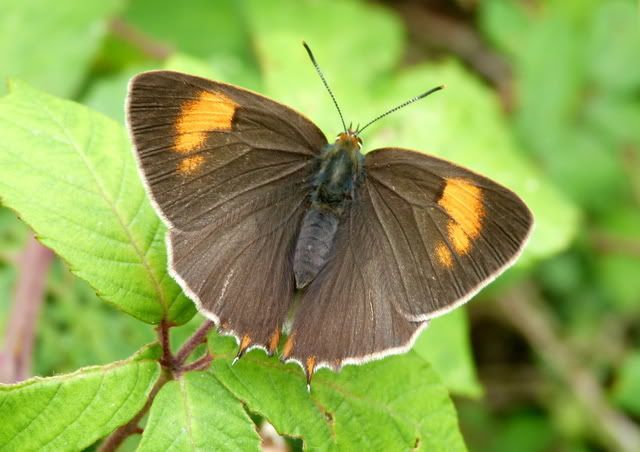
In addition to the 12 species seen at Bentley, a further 5 were found at this site:
Holly Blue
Brown Hairstreak
Small Skipper
Marbled White
Purple Hairstreak
After leaving Bentley Wood, I drove to Alner's Gorse, arriving at about 12.30pm. My first surprise was bumping into fellow UKB member Jenks, who was bemoaning the fact that he'd forgotten his password and couldn't post at the moment! Still, he reassured me by telling me he'd seen 4 Brown Hairstreaks so I trotted off round the corner and sure enough, there was a male on the brambles as well as another male on a thistle.
After observing these two for a while, I meandered through this Hairstreak heaven, and cursed when I walked under an Oak and disturbed a Purple Hairstreak that must have been at shoulder level.
It went temporarily cloudy, so I explored some of the grassland before returning to the same swathe of hedgerow that had produced the first BH. This time there was a female nectaring wings shut on bramble. She had an audience for a while before people drifted off leaving just me as the sole observer. I gently rustled the foliage beneath her using my bespoke 'Hairstreak Stick', and she fluttered around before landing on a leaf immediately in front of my nose. Now in basking rather than feeding mode, it wasn't long before those wings slowly eased apart:



In addition to the 12 species seen at Bentley, a further 5 were found at this site:
Holly Blue
Brown Hairstreak
Small Skipper
Marbled White
Purple Hairstreak
Re: July 2011
Sunday 31 July - Part 3
The drive from Alner's to Ballard Down near Swanage was depressing for two reasons - the progressively increasing cloud cover and the traffic for Corfe Castle. I only arrived at 3.40pm and once I got onto the Down itself it was actually quite cool.
I disturbed plenty of Wall Browns as I walked along the path:
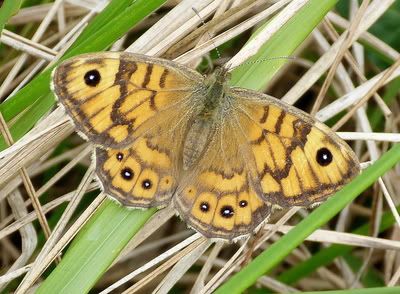
Plenty of Marbled Whites - some looked very fresh too:
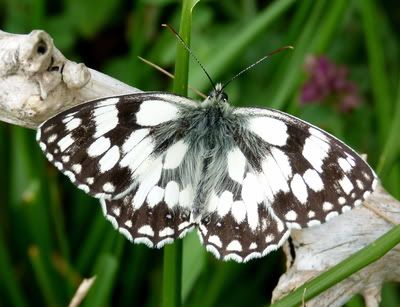
I was worried that the cool conditions would keep the Adonis Blues hunkered down in the long grass. To a degree this must have been true, as I only saw 8 or 9 of them:

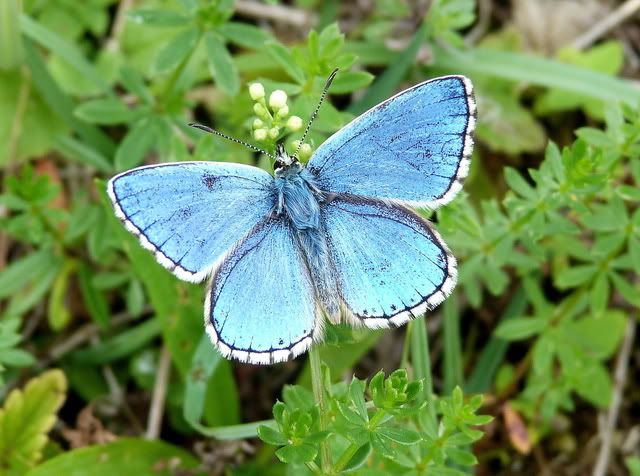
The views from the top of the Down were excellent in both directions.
Here's Swanage:
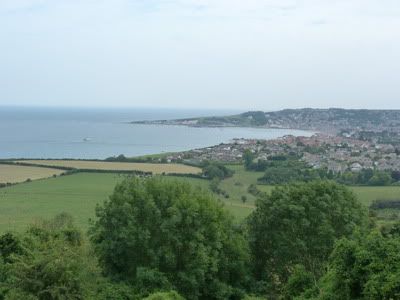
..and the UK's most expensive real estate - Sandbanks, near Poole:
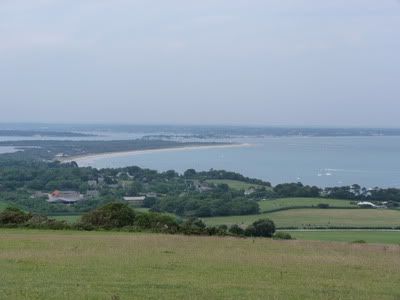
Even though this site is as far south as you can get this female Dark Green Fritillary was in impressively mint condition (the ones in south Wales are decidedly tatty)
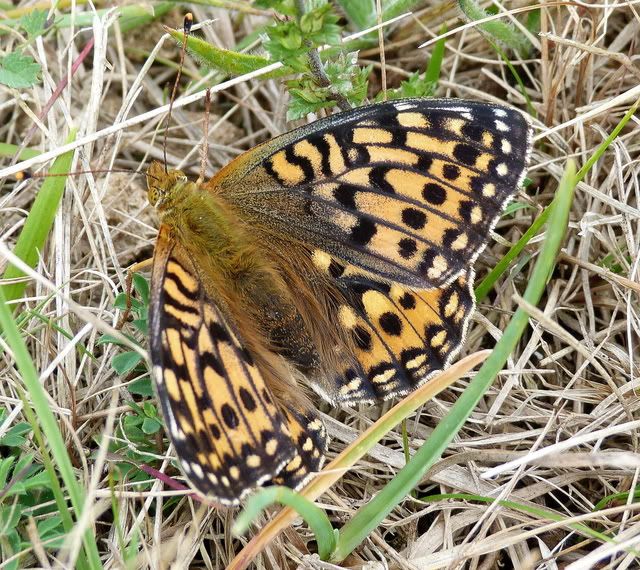
The biggest surprise of the day was the first ever 2nd brood Dingy Skipper I've seen:
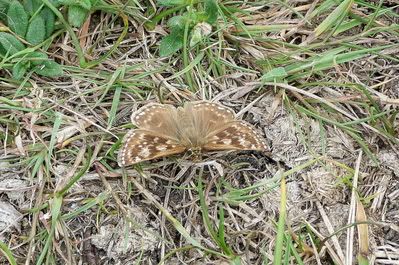
I was mindful that I'd seen no Lulworth Skippers as I prepared to leave the site (in fact, no Skippers at all apart from the Dingy). As I walked through the field approaching the exit I saw something small buzz round the short grass. It landed on a stem and looked very, very small. Sadly, before I'd even focused in on the subject it zoomed off and I couldn't track it to see where it had come down. I spent the next 20 minutes combing the field, but when I found two Small Skippers as a result of this search, I started to seriously question my instinct that the first one had been a Lulworth.
Still, there were another 10 species to add to the day's tally:
Comma
Wall Brown
Common Blue
Small Copper
Adonis Blue
Dark Green Fritillary
Grayling
Brown Argus
Dingy Skipper
Small Tortoiseshell
So, I managed to see 27 species in a day which, I have to say, was a slight disappointment. I thought 30 was a realistic target, as although I hadn't factored in Dingy Skipper I'd certainly anticipated seeing Chalkhill Blue, Small Heath and Small Blue, and reckoned there was an outside chance of three or four others.
Nonetheless, it was an enjoyable if exhausting day and one no doubt that I'd be yearning to repeat when stuck indoors in the middle of a grey and miserable November afternoon.
The drive from Alner's to Ballard Down near Swanage was depressing for two reasons - the progressively increasing cloud cover and the traffic for Corfe Castle. I only arrived at 3.40pm and once I got onto the Down itself it was actually quite cool.
I disturbed plenty of Wall Browns as I walked along the path:

Plenty of Marbled Whites - some looked very fresh too:

I was worried that the cool conditions would keep the Adonis Blues hunkered down in the long grass. To a degree this must have been true, as I only saw 8 or 9 of them:


The views from the top of the Down were excellent in both directions.
Here's Swanage:

..and the UK's most expensive real estate - Sandbanks, near Poole:

Even though this site is as far south as you can get this female Dark Green Fritillary was in impressively mint condition (the ones in south Wales are decidedly tatty)

The biggest surprise of the day was the first ever 2nd brood Dingy Skipper I've seen:

I was mindful that I'd seen no Lulworth Skippers as I prepared to leave the site (in fact, no Skippers at all apart from the Dingy). As I walked through the field approaching the exit I saw something small buzz round the short grass. It landed on a stem and looked very, very small. Sadly, before I'd even focused in on the subject it zoomed off and I couldn't track it to see where it had come down. I spent the next 20 minutes combing the field, but when I found two Small Skippers as a result of this search, I started to seriously question my instinct that the first one had been a Lulworth.
Still, there were another 10 species to add to the day's tally:
Comma
Wall Brown
Common Blue
Small Copper
Adonis Blue
Dark Green Fritillary
Grayling
Brown Argus
Dingy Skipper
Small Tortoiseshell
So, I managed to see 27 species in a day which, I have to say, was a slight disappointment. I thought 30 was a realistic target, as although I hadn't factored in Dingy Skipper I'd certainly anticipated seeing Chalkhill Blue, Small Heath and Small Blue, and reckoned there was an outside chance of three or four others.
Nonetheless, it was an enjoyable if exhausting day and one no doubt that I'd be yearning to repeat when stuck indoors in the middle of a grey and miserable November afternoon.
